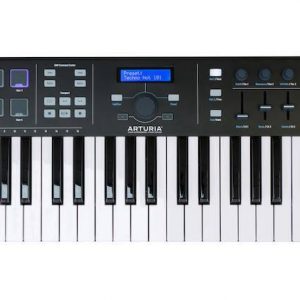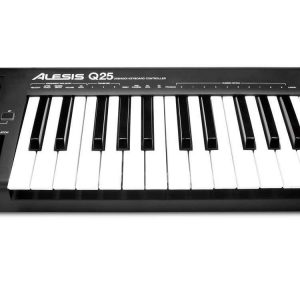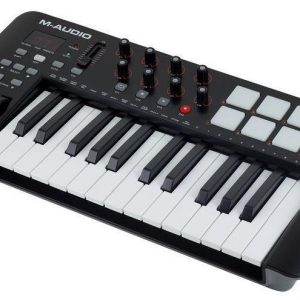Akai MPK Mini Plus
$126.99
Experience full creative control with the versatile Akai MPK Mini Plus MIDI device, perfect for beginners and professionals alike!
Compare
Description
The Akai MPK Mini Plus MIDI device is a powerful and compact controller designed for musicians and music producers who are on-the-go. With its sleek and stylish design, this MIDI controller is perfect for anyone who needs a portable solution for creating and producing music.
One of the best things about the Akai MPK Mini Plus is its intuitive interface. The fully-featured keyboard is combined with eight MPC-style drum pads, providing users with an incredibly flexible and versatile platform for creating beats, melodies, and other musical elements. The device also features a built-in arpeggiator, which is great for quick and easy chord progressions.
In addition to its intuitive interface, the Akai MPK Mini Plus is also highly customizable. The device comes with a variety of assignable controls, including knobs and buttons, that allow users to assign different functions to specific buttons or pads. This means that you can customize the controller to suit your specific needs, whether you’re using it for live performances or recording sessions.
Another great feature of the Akai MPK Mini Plus is its compatibility with a wide range of software applications. The device is fully compatible with most Digital Audio Workstations (DAWs) and software synthesizers, including Ableton Live, FL Studio, and GarageBand. Additionally, the controller comes with a bundled software package that includes several premium virtual instruments and a series of custom plug-ins.
Overall, the Akai MPK Mini Plus is an excellent choice for anyone looking for a powerful, intuitive, and highly customizable MIDI controller. Whether you’re a professional musician or a hobbyist, this device is sure to provide you with everything you need to create amazing music on the go. With its compact size and powerful performance, the Akai MPK Mini Plus is an outstanding addition to any music producer’s toolkit.
Akai MPK Mini Plus properties
| Product name |
Akai MPK Mini Plus |
| Brand |
Akai |
| Type |
MIDI Keyboards |
| Keys |
Yes |
| Number of Keys |
37 pcs |
| Drawbars/Sliders |
No |
| Pads |
Yes |
| Rotary Controls |
Yes |
| Modulation Wheel |
Yes |
| Pre-Programmed Rythms |
No |
| Pre-Programmed Songs |
No |
| Pre-Programmed Sounds |
No |
| Pre-Programmed Drumset |
No |
| Pre-Programmed Effects |
No |
| Built-In Tuner |
No |
| Connections |
3.5mm (AUX), MIDI, USB |
| Colour |
Black |
| Power Supply |
Electrical Cable to Wall Socket, USB |
Frequently Asked Questions:
What are the main steps to set up and connect my Akai MPK Mini Plus with my computer for the first time?
Setting up and connecting your Akai MPK Mini Plus for the first time is quite easy. Here's a step-by-step guide:
1. **Unbox the device**: Carefully open the box containing your Akai MPK Mini Plus, making sure not to damage any of the components inside.
2. **Power on the device**: Plug in the USB cable that came with your MPK Mini Plus into the unit itself and then plug it into a free USB port on your computer. The power light will turn on, indicating that the device is ready for use.
3. **Install necessary software (if applicable)**: Depending on what you plan to use the MPK Mini Plus for, you may need to install additional software from Akai Professional or other third-party vendors. Check the included documentation or visit the manufacturer's website for more information about required software and installation instructions.
4. **Connect your MIDI devices**: If you want to connect external MIDI instruments like synthesizers, drum machines, etc., now is the time to do so using appropriate MIDI cables. Remember that not all devices may require external connections; check their specifications if you're unsure.
5. **Configure settings**: Launch your preferred digital audio workstation (DAW) or music production software and make sure it recognizes the MPK Mini Plus as a valid MIDI controller. You might need to adjust settings within your software to ensure proper functionality.
6. **Assign controls**: Most modern DAWs will automatically map the knobs, pads, and sliders of the MPK Mini Plus upon detection. However, if you want more granular control over these assignments or need to adjust them for a specific project, consult your software's documentation on how to do this.
7. **Start creating music**: Now that everything is set up correctly, you can start composing and producing music using your Akai MPK Mini Plus! Enjoy the versatile capabilities of this handy MIDI controller.
How does the inclusion of Akai Professional's Pro Motion HyperSensitive technology in the MPK Mini Plus impact its performance capabilities?
The integration of Akai Professional's Pro Motion HyperSensitive technology in the MPK Mini Plus significantly enhances its performance capabilities. This advanced technology enables highly responsive and expressive performances by the user, allowing for greater dynamic control over sounds and samples. It also provides an ultra-fast response time, which is crucial for capturing every nuance of a performance accurately. Overall, the Pro Motion HyperSensitive technology in MPK Mini Plus sets it apart from other similar devices in terms of its exceptional performance capabilities.
How does the Akai MPK Mini Plus's expanded MPC functionality enhance its capabilities beyond traditional MIDI controllers?
The Akai MPK Mini Plus is not just a typical MIDI controller; it's an advanced instrument that expands upon traditional MIDI controllers with its enhanced MPC functionality. The MPC (Music Production Center) feature allows users to access and manipulate samples, loops, and sequences directly from the keyboard, providing greater creative freedom and flexibility in production. With 12 highly-sensitive pads for triggering samples, loops, or playing drums, as well as a built-in arpeggiator, step sequencer, and note repeat functionality, the MPK Mini Plus becomes an all-in-one production tool that goes beyond traditional MIDI controllers' capabilities. In essence, this keyboard transforms into a portable production studio, enabling users to create music wherever they go.
How can I effectively map and program custom MIDI assignments on the Akai MPK Mini Plus keyboard for optimal performance during live shows and studio sessions?
Familiarize yourself with the Akai MPK Mini Plus keyboard's features and functions, including its MIDI capabilities and software integration options. Determine which specific MIDI assignments you want to create for your desired performances. This could include things like mapping different sounds or effects to specific keys, setting up custom drum patterns, or configuring parameter controls for your favorite plugins. Use the keyboard's built-in software editor to map out your desired assignments. The software should allow you to easily drag and drop MIDI assignments onto specific keys or pads, and may offer additional features like velocity sensitivity and aftertouch control. Test your new assignments in both live and studio settings to ensure they work seamlessly with your equipment and software. Continuously refine and optimize your MIDI assignments over time as you gain more experience and familiarity with the keyboard's capabilities. Back up your custom assignments regularly to prevent losing them if the keyboard or software experiences any issues. Consider investing in additional hardware or software tools, such as external MIDI controllers or virtual instruments, to expand your performance options and further enhance your live shows and studio sessions. Finally, always strive to perform at the highest level possible by practicing regularly, staying focused and engaged during performances, and delivering a truly memorable experience for your audience.
What is the recommended way to update the firmware of an Akai MPK Mini Plus MIDI keyboard when it's connected via USB and not directly to a computer?
To update the firmware of an Akai MPK Mini Plus MIDI keyboard that's connected via USB, but not directly to a computer, you have a few options. Firstly, you can use a hub. A USB hub is a simple solution for this problem. You can connect your MIDI keyboard to the hub and then connect the hub to your computer. This way, you can update the firmware without having to physically connect the keyboard to the computer. Another option is to use an OTG (On-The-Go) adapter. An OTG adapter is a small device that allows you to connect two USB devices together, creating a new virtual USB port. You can plug your MIDI keyboard into one end of the OTG adapter and then plug the other end into your computer. Lastly, if neither of these options work for you, you may need to use a custom solution such as a Raspberry Pi or an Arduino board to act as a bridge between the keyboard and your computer. This will likely require some programming knowledge. It's worth noting that updating the firmware of a MIDI device can sometimes cause issues with compatibility or functionality, so it's essential to make sure you're downloading the correct update from a reliable source before proceeding.
Before you buy Akai MPK Mini Plus






Reviews
There are no reviews yet.